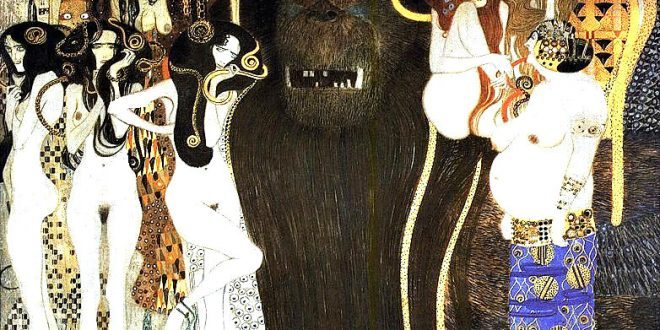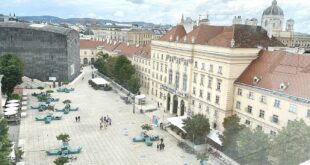Are you as passionate as me about Gustav Klimt artwork? I was lucky enough to be born at the centre of his artistic work in Vienna. You are going to benefit from my Klimtmania with this one page appetiser: Gustav’s life in brief, what makes his art so brilliant and a closeup of his top 7 paintings.
Gustav Klimt Artwork: What Makes It Special
Above all, Gustav Klimt artwork is characterised by translucent females with flowing big hair, spooky monsters, overboarding nature, and most of all, rich ornaments. Throughout most of his work, Klimt liked soft pastels, vibrant reds and rich yellows, and often gold plated his ornamental work.
In particular, Klimt loved allegories, Ancient, Medieval and Italian art. When in Vienna, you can see most Gustav Klimt paintings, drawings, sketches, frescoes, and exhibition posters at the Austrian National Gallery at Belvedere Palace, and at Wien Museum. To connect more closely with Klimt’s life in Vienna, visit his former studio at the Klimt Villa.
Gustav Klimt In Brief
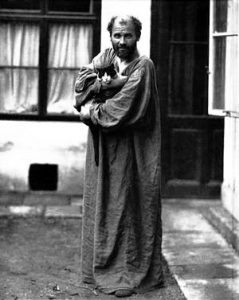
To understand the role of Gustav Klimt artwork in Vienna, take a brief look at the artist’s life: Gustav Klimt (1862 to 1918) is one of Europe’s most famous Jugendstil (Art Nouveau) painters and incorporates the Austrian style of Art Nouveau (Jugendstil). As such, he has become one of the most popular representatives of Vienna art. A the end of the 19th century, Klimt co-founded the artists’ group Wiener Secession, a rebel group of young artists who parted from the conservative Austrian Artists’ Association (Künstlerhaus). Throughout his time in Vienna, Klimt worked in six different studios. His last studio, located at Klimt Villa in Hietzing, is open to the public.
Top Seven Gustav Klimt Paintings
Early Gustav Klimt artwork was classic and inspired by artists like Makart. You can see this clearly with the portrait of Judith. His own distinctive style became apparent during his Golden Period. He loved classic Italian, old Egyptian, Byzantine and Medieval art, but most of all women. In most Gustav Klimt artwork, you will also find allegoric symbols. Oil on canvas and lots of gold and silver leaf for paintings like Gustav Klimt’s The Kiss or Portrait of Adele Bloch Bauer characterise Klimt’s painting technique.
Until today, the international art world trades Gustav Klimt artwork exceptionally high. Klimt paintings are auctioned for stellar prices, such as the portrait of Adele Bloch Bauer (USD 135m) or Litzlberg am Attersee (USD 40m).
Gustav Klimt Artwork 1: The Kiss
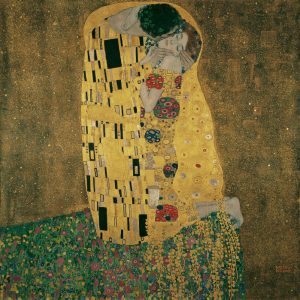 With The Kiss Klimt created one of the centre pieces of Vienna art, which is being revered in Vienna like Mona Lisa is at the Parisian Louvre. Klimt stylises the love between man and woman, dissolving the classical portrait through rich ornanmental design. Just the two faces close to each other, a female shoulder, two hands, and two feet are visible, whereas their richly decorated wide gowns are flowing into one another. The couple stands on a colourful carpet of flowers. This is not about human bodies any more, but about what holds mankind and nature together: Love and Beauty.
With The Kiss Klimt created one of the centre pieces of Vienna art, which is being revered in Vienna like Mona Lisa is at the Parisian Louvre. Klimt stylises the love between man and woman, dissolving the classical portrait through rich ornanmental design. Just the two faces close to each other, a female shoulder, two hands, and two feet are visible, whereas their richly decorated wide gowns are flowing into one another. The couple stands on a colourful carpet of flowers. This is not about human bodies any more, but about what holds mankind and nature together: Love and Beauty.
Where To See It Belvedere Vienna;
Gustav Klimt Artwork 2: Adele Bloch Bauer
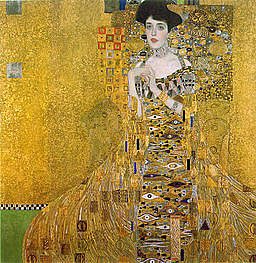 Who was Adele Bloch Bauer? Especially if you have seen the movie The Woman in Gold, you will know. In fact, Adele was an affluent Austrian, the wife of a local sugar manufacturer and daughter of a bank director. Her husband was one of the patrons of Klimt. Her portrait resembles a cut and paste art collage, as is typical for the Golden Period of Gustav Klimt artwork. Space is flattened into a whirl of decorative patterns.
Who was Adele Bloch Bauer? Especially if you have seen the movie The Woman in Gold, you will know. In fact, Adele was an affluent Austrian, the wife of a local sugar manufacturer and daughter of a bank director. Her husband was one of the patrons of Klimt. Her portrait resembles a cut and paste art collage, as is typical for the Golden Period of Gustav Klimt artwork. Space is flattened into a whirl of decorative patterns.
In the painting, three dimensional objects, like the chair on which Adele sits, are barely visible. During World War II, the Nazis seized the painting, dating from Klimt’s Golden Period. In 2006, Maria Altmann, Adele’s niece and rightful heir, received the painting back per order of court. In the end, Ronald Lauder bought the painting in the same year for USD 135 million. It became the second most expensive work of art in the world.
Where To See It New Gallery, Manhattan, New York;
Gustav Klimt Artwork 3: The Klimt Beethoven Frieze
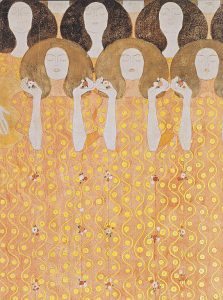 A symphony in pictures at the Vienna Secession: The monumental Klimt Beethoven frieze introduces Klimt’s Golden Period and visualises Richard Wagner’s famous interpretation of Beethoven’s 9th symphony. Joy, passion, violence, illness, madness, death, the arts, lust and unchastity have been turned into allegories of sketchy females with mostly big hair, surrounded or covered by rich golden ornaments.
A symphony in pictures at the Vienna Secession: The monumental Klimt Beethoven frieze introduces Klimt’s Golden Period and visualises Richard Wagner’s famous interpretation of Beethoven’s 9th symphony. Joy, passion, violence, illness, madness, death, the arts, lust and unchastity have been turned into allegories of sketchy females with mostly big hair, surrounded or covered by rich golden ornaments.
This Kiss To The Whole World, a line from the Ninth Symphony entitles the frieze. Klimt created the frieze for the 14th exhibition of the Association of Visual Artists of Austria’s Secession in 1902. The naked females and shocking expressions of death, madness and illness provoked outrage among many Viennese and the broader public. The frieze covers three walls of a large basement hall at theSecession and is the only permanent exhibition there.
Where To See It Secession, Karlsplatz, A-1010 Vienna
Gustav Klimt Artwork 4: The Fulfilment
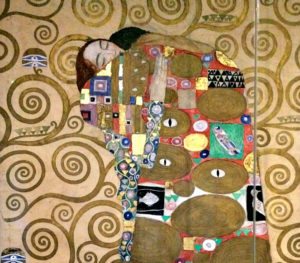 A man and woman deeply embrace each other. But, like with The Kiss, the real message is in the ornanments which cover them almost entirely. The woman’s flower dress makes her the symbol of the earth that melts with the male sun. The male lover’s coat is covered with old Egyption symbols of the sun god. (source: Dr. Christine Pellech) The whirls in the background represent the tree of life. In The Fulfilment, Klimt expanded the theme of lovers from the Beethovenfrieze with a meaning that embraces life and the universe itself. The drawing is based on one of Klimt’s three mosaic friezes in 15 parts for the dining room of Brussels-based Stoclet Palace, which had been designed by his architect friend and fellow Austrian Josef Hoffmann. The other significant mosaic friezes areExpectation, showing a single woman, and Tree of Life, showing the tree used as a background in Fulfilment and Expectation.
A man and woman deeply embrace each other. But, like with The Kiss, the real message is in the ornanments which cover them almost entirely. The woman’s flower dress makes her the symbol of the earth that melts with the male sun. The male lover’s coat is covered with old Egyption symbols of the sun god. (source: Dr. Christine Pellech) The whirls in the background represent the tree of life. In The Fulfilment, Klimt expanded the theme of lovers from the Beethovenfrieze with a meaning that embraces life and the universe itself. The drawing is based on one of Klimt’s three mosaic friezes in 15 parts for the dining room of Brussels-based Stoclet Palace, which had been designed by his architect friend and fellow Austrian Josef Hoffmann. The other significant mosaic friezes areExpectation, showing a single woman, and Tree of Life, showing the tree used as a background in Fulfilment and Expectation.
Where To See It Museum of Applied Arts/Contemporary Art, A-1010 Vienna (drawing): Stoclet Palace, Brussels (friezes)
Gustav Klimt Artwork 5: Death And Life
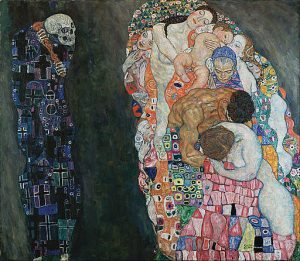 Life would be a beautiful dream if there wasn’t death standing right next to it. In his allegory of death and life, Klimt visualises death as a single nasty threat that stands well apart of life, rather than forming part of it. Life itself comes in different shapes, from babies to young people and an old woman. Painted in 1910, the painting was awarded the first prize of the International Art Exhibtion in Rome a year later. In 1915, he overhauled parts of the painting, such as the background and some of the ornaments.
Life would be a beautiful dream if there wasn’t death standing right next to it. In his allegory of death and life, Klimt visualises death as a single nasty threat that stands well apart of life, rather than forming part of it. Life itself comes in different shapes, from babies to young people and an old woman. Painted in 1910, the painting was awarded the first prize of the International Art Exhibtion in Rome a year later. In 1915, he overhauled parts of the painting, such as the background and some of the ornaments.
Where To See It Sammlung Leopold, Leopold Museum at the Museumsquartier
Gustav Klimt Artwork 6: Judith i
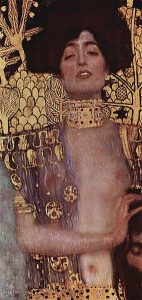 With Judith, Klimt created a unique portrait of biblical Jewish heroine Judith. To save her people from slavery, Judith first seduced and then killed the Assyrian leader Holofernes who desired her in his sleep.
With Judith, Klimt created a unique portrait of biblical Jewish heroine Judith. To save her people from slavery, Judith first seduced and then killed the Assyrian leader Holofernes who desired her in his sleep.
But not only does the painting show a strong triumphant woman. As the first artist, Klimt portrayed Judith as a highly erotic individual whose slight smile reveals that she may even have enjoyed decapitating Holofernes. If you take a closer look, Judith shows more Viennese than Middle Eastern features. In fact, she looks very much like Adele Bloch Bauer! As for the use of colours, Klimt used the palette of old Egyptian art, such as the sun’s gold and ebony black.
Where To See It Upper Belvedere, A-1030 Vienna
Gustav Klimt Artwork 7: Emilie Flöge
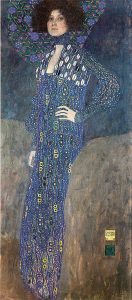 Just one look at the painting and it becomes clear that Emilie was an early model of a revolutionary Austrian female. As a matter of fact, the fashion designer and entrepreneur designed the first local dresses to wear without a corset and sold them in her shop that she co-owned with her sister Helene. But Emilie was not just a business woman, she was also Klimt’s long-standing partner and muse. In the portrait, she incorporates a self-confident, beautiful and modern woman. Like a rock herself, she is standing firmly between two rocks, while the patterned cushion-like patch behind her provides additional glow to her hair and face.
Just one look at the painting and it becomes clear that Emilie was an early model of a revolutionary Austrian female. As a matter of fact, the fashion designer and entrepreneur designed the first local dresses to wear without a corset and sold them in her shop that she co-owned with her sister Helene. But Emilie was not just a business woman, she was also Klimt’s long-standing partner and muse. In the portrait, she incorporates a self-confident, beautiful and modern woman. Like a rock herself, she is standing firmly between two rocks, while the patterned cushion-like patch behind her provides additional glow to her hair and face.
Where To See It Vienna Museum (Wien Museum), Karlsplatz, A-1010 Vienna
All pictures on this page were made available through Wikimedia’s Creative Commons License
Quick Links For Art Lovers In Vienna
The Best Vienna Museums: 17 Simple Choices
Learn more about Vienna Art from Baroque and Biedermeier to Modernism
explore more Vienna Tourism Essentials
back to Vienna Unwrapped homepage
